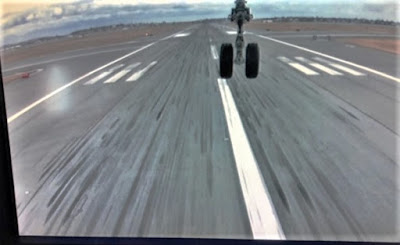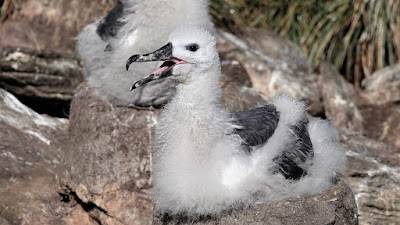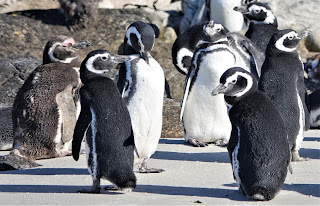"It was the best of times, it was the worst of times, it was the age of wisdom, it was the age of foolishness, it was the epoch of belief, it was the epoch of incredulity, it was the season of Light, it was the season of Darkness, it was the spring of hope, it was the winter of despair, we had everything before us, we had nothing before us, we were all going direct to Heaven, we were all going direct the other way..." Charles Dickens, A Tale of Two Cities
Here’s where the trip took a turn for the worse as the whole world was reeling with the virus. We were due to arrive in Cape Town a day early since we once again made fast time across an expanse of the ocean that was due to experience bad weather. Our expedition leader arranged several tours for the extra day, which most people enthusiastically signed on to. The next day (at sea), we were told those tours would be cancelled because an edict had been issued by South Africa that people shouldn’t congregate in large groups or travel in busses. Since we’d all been following the news, we understood the situation. We were also told that once the ship was cleared by customs, we would be free to go around the city on our own. It was understood that we had been in the equivalent of quarantine for 3 weeks due to being on the ocean and visiting mostly uninhabited islands, and we were all virus free. There was also little or no virus in Cape Town.
As the news had been getting more dire, we decided that we should cancel our safari in Tanzania and make new arrangements to fly home. We tried for several days to reach AMEX (the travel agent who booked our return air tickets) with no response. We also tried to contact the issuing airline of the ticket (Alitalia). We knew that was a lost cause since Italy was badly affected. So, we did the next best thing and booked a new ticket to return on Delta Airlines with no intermediate stops overseas on the day the cruise ended.
(Cape Town--Sorry for poor quality)
Finally, after 3 weeks on the ocean, the day arrived when we awoke and saw the coastline of the beautiful city of Cape Town. However, instead of going into the port, we started sailing in a loop back and forth off the coast for an entire day. We had been notified that overnight a decision had been made to close the ports. So, the President and Transport Minister met that day and debated our future arrival. They already knew that our ship and its passengers were virus free, and we had previously been given approval. Around 5:00PM that day, after a meeting that lasted 8 hours, we were told that approval had been given by the Transport Minister and the President of South Africa for us to come in and dock. But we still circled the coastline for another day awaiting instructions to come in. Passengers were starting to miss their flights, if those flights were taking off at all, since many had been cancelled.
Finally arriving at Cape Town Port
Eventually, we were given the ok to move the ship to the port but were sent to the container port for the night. The next morning, approval was given to move to the cruise ship port. We thought that was an encouraging sign and still hoped to make our flight later that day. Well, another day of waiting ensued with no authorities giving us clearance to leave the ship. At this point, we didn’t know how or when to rebook our flights home.
Cruise Ships in Cape Town
(2,000 pax each - ours 170)
All in all, we spent 6 days on the ship in the port. The ship’s staff couldn’t have been more wonderful and gracious to us in their efforts to wine, dine and entertain us. They, too, were in limbo, since several of them were finishing their contracts and just wanted to go home. They all showed the best of human nature and their concerted efforts to resolve what they could and deal with the rest. Once we were finally cleared to leave the ship, we made another attempt to book a new ticket. It took a couple of days to be able to complete a reservation. The internet was very slow and frequently timed out. Telephone connections were similar. Eventually, we did succeed. If we hadn’t, Silversea would have gotten the tickets, but we would not have had any choice regarding the flights. Passengers were only allowed to leave the ship in time for their flights to depart South Africa. They were sent in groups and escorted by officials.
Captain Eric bids farewell to every passenger
Excitement and anxiety built as we left our safe bubble of the ship on the third day. I think I even heard a pop as I transited the threshold into a new, unknown version of the world. We were escorted in a group of eight to a bus and taken to the airport. Check-in went smoothly; we found a sparsely populated lounge. Take off was on time during a lovely sunset.



Sigh of relief! We slept comfortably in our cubicle beds until the middle of the night when the Captain made an announcement that he would be diverting the flight to Oman, rather than continuing to Doha, Qatar. We made a quick descent into the Salalah Airport and deplaned into the gate area. It was announced shortly after that another plane would be sent from Doha to complete the flight. Unfortunately, that meant most everyone would be missing their ongoing connections to the States and Europe. After about 5 hours, the plane from Doha arrived and we were flown to the airport in Qatar. While waiting in Oman, we had once again rebooked our continuing flight for the next day nonstop to Boston.
On arrival in Doha, airline representatives were waiting for us, and we were escorted to the lounge. Qatar had closed its borders to foreigners, so we were unable to leave the airport for an overnight stay at a hotel. There was a transit hotel at the airport but that was closed, too. So, we were taken to a semi-private area behind the lounge with cubicles containing a couch and chair where we could spend the night. Showers and bathrooms were provided nearby. So were food and beverages. Dave described it as a 5 star hotel with no rooms.
Qatar Airport Lounge - Nearly Empty
The next morning all went well as we took off for our nonstop flight to Boston. It was a long flight but comfortable. When we arrived in Boston, we were quite surprised that there were no health forms to fill out and no health screening at all. The international arrivals area was totally empty, and there were only a couple of immigration officers on duty. Neither they nor any other airport employees were wearing any kind of protective gear—no masks or gloves. We heard the same story from some other passengers who arrived at JFK. We thought that was unbelievable, especially since even the 3rd world countries we had transited through provided temperature checks and forms to fill out.
Touching down in Boston
The Rental Chariot--License Plate--"The Spirit of America"
After obtaining a rental car, we drove home through mostly empty roads in Boston. It was quite eerie to see no one on the road at rush hour in the city. We’re now glad to be back home and will stay in for the next 14 days. We have a good friend and neighbor who is getting us needed groceries and checking on us. Thankfully, the stores do have most things that are necessary. Our biggest wish is to stay healthy, to have our family and friends stay healthy, in fact to have everyone stay healthy and to have this pandemic over as soon as it can be.
In the quote from Dickens, “It was the best of times, it was the worst of times…”, I found my thoughts about the trip. The ‘highs’ of visiting such beautiful, remote, untouched parts of the world represented the best of times. Following the progression of a pandemic ravaging the world was surely the lowest of the lows and the worst of times.
Through it all, we were able to witness some of the best of human nature in our fellow passengers and the ship’s crew. Although the crew was anxious about their futures and their families spread out across the world, they never once showed their worries, and instead greeted us with smiles and continued to provide excellent service. Most of our fellow passengers took the situation in stride and had confidence that they would get home. Some were even planning their next adventures. As in other uncertain situations, we all bonded in our shared circumstances. We did learn just before leaving the ship that permission had been denied for all crew members to leave the ship to go home, so as I’m writing this, I believe they are sailing north along the west coast of Africa. I know they will be fine. I can almost see the ornithologists and biologists out on deck or in the observation lounge looking for birds and whales with binoculars and cameras.
Bon Voyage, my friends!


















































